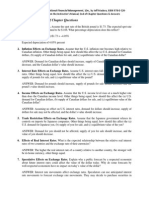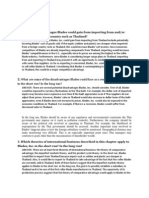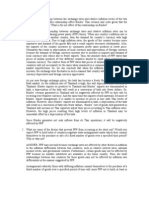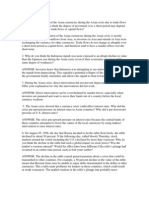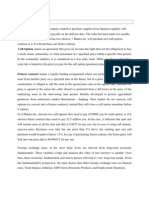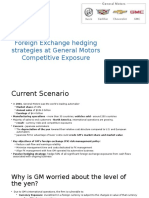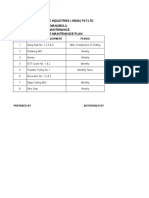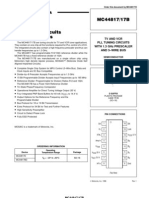Blades, Inc. Case
Blades, Inc. Case
Uploaded by
Sam ChauCopyright:
Available Formats
Blades, Inc. Case
Blades, Inc. Case
Uploaded by
Sam ChauOriginal Description:
Copyright
Available Formats
Share this document
Did you find this document useful?
Is this content inappropriate?
Copyright:
Available Formats
Blades, Inc. Case
Blades, Inc. Case
Uploaded by
Sam ChauCopyright:
Available Formats
Solution to Continuing Case Problem: Blades, Inc.
1. One point of concern for you is that there is a tradeoff between the higher interest rates in Thailand and the delayed conversion of baht into dollars. Explain what this means. ANSWER: If the net baht-denominated cash flows are converted into dollars today, Blades is not subject to any future depreciation of the baht that would result in less dollar cash flows. 2. If the net baht received from the Thailand operation are invested in Thailand, how will U.S. operations be affected? (Assume that Blades is currently paying 10 percent on dollars borrowed, and needs more financing for its firm.) ANSWER: If the cash flows generated in Thailand are all used to support U.S. operations, then Blades will have to borrow additional funds in the U.S. (or the international money market) at an interest rate of 10 percent. For example, if the baht will depreciate by 10 percent over the next year, the Thai investment will render a yield of roughly 5 percent, while the company pays 10 percent interest on funds borrowed in the U.S. Since the funds could have been converted into dollars immediately and used in the U.S., the baht should probably be converted into dollars today to forgo the additional (expected) interest expenses that would be incurred from this action. 3. Construct a spreadsheet that compares the cash flows resulting from two plans. Under the first plan, net baht-denominated cash flows (received today) will be invested in Thailand at 15 percent for a one-year period, after which the baht will be converted to dollars. The expected spot rate for the baht in one year is about $0.022 (Ben Holts plan). Under the second plan, net baht-denominated cash flows are converted to dollars immediately and invested in the U.S. for one year at 8 percent. For this question, assume that all baht-denominated cash flows are due today. Does Holts plan seem superior in terms of dollar cash flows available after one year? Compare the choice of investing the funds versus using the funds to provide needed financing to the firm. ANSWER: (See spreadsheet attached.) If Blades can borrow funds at an interest rate below 8 percent, it should invest the excess funds generated in Thailand at 8 percent and borrow funds at the lower interest rate. If, however, Blades can borrow funds at an interest rate above 8 percent (as is currently the case with an interest rate of 10 percent), Blades should use the excess funds generated in Thailand to support its operations rather than borrowing.
Plan 1Ben Holt's Plan
Calculation of baht-denominated revenue: Price per pair of "Speedos" Pairs of "Speedos" = Baht-denominated revenue Calculation of baht-denominated cost of goods sold: Cost of goods sold per pair of "Speedos" Pairs of "Speedos" = Baht-denominated expenses Calculation of dollar receipts due to conversion of baht into dollars: Net baht-denominated cash flows now (826,920,000 206,712,000) Interest earned on baht over a one-year period (15%) Baht to be converted in one year 4,594 180,000 826,920,000
2,871 72,000 206,712,000
620,208,000 93,031,200 713,239,200
Expected spot rate of baht in one year = Expected dollar receipts in one year
$ 0.022 $ 15,691,262
Plan 2Immediate Conversion
Calculation of baht-denominated revenue: Price per pair of "Speedos" Pairs of "Speedos" = Baht-denominated revenue 4,594 180,000 826,920,000
Calculation of baht-denominated cost of goods sold: Cost of goods sold per pair of "Speedos" Pairs of "Speedos" = Baht-denominated expenses
2,871 72,000 206,712,000
Calculation of dollar receipts due to conversion of baht into dollars: Net baht-denominated cash flows to be converted (826,920,000 206,712,000) Spot rate of baht now = Dollar receipts now Interest earned on dollars over a one-year period (8%) = Dollar receipts in one year
620,208,000 $ 0.024 $ 14,884,992 1,190,799 $ 16,075,791
Calculation of dollar difference between the two plans:
Plan 1 Plan 2 Dollar difference $ 15,691,262 16,075,791 $ (384,529)
Thus, the cash flow generated in one year by Plan 1 exceed those generated by Plan 2 by approximately $384,529. Therefore, Ben Holt's plan should not be implemented.
You might also like
- Did The Intervention Effort by The Thai Government Constitute Direct or Indirect InterventionDocument3 pagesDid The Intervention Effort by The Thai Government Constitute Direct or Indirect InterventionXiao Ting71% (7)
- Verbi Irregolari Inglesi - Elenco Completo - Corsi-di-IngleseDocument5 pagesVerbi Irregolari Inglesi - Elenco Completo - Corsi-di-IngleseDonato Cavallo0% (2)
- International Financial Management Chapter 9 Case StudyDocument4 pagesInternational Financial Management Chapter 9 Case Studypizzachicagostyle2711100% (2)
- MBF14e Chap06 Parity Condition PbmsDocument23 pagesMBF14e Chap06 Parity Condition PbmsKarl100% (18)
- Blade Inc Chapter 7Document5 pagesBlade Inc Chapter 7Zahid Rizvy100% (2)
- Ch.4 Answers To End of Chapter QuestionsDocument9 pagesCh.4 Answers To End of Chapter Questionspoiriejs100% (5)
- Assessment of Future Exchange Rate MovementsDocument3 pagesAssessment of Future Exchange Rate MovementsNafiz Zaman100% (1)
- Blades PLC Case StudyDocument7 pagesBlades PLC Case StudyMohd Farid100% (1)
- Blades PLC: International Flow of Funds: A Case StudyDocument10 pagesBlades PLC: International Flow of Funds: A Case StudyKristelle Brooke Dianne Jarabelo100% (2)
- IFM Capital BudgetingDocument4 pagesIFM Capital Budgetingjayson RebeiroNo ratings yet
- Q A ch13Document11 pagesQ A ch13selyabiNo ratings yet
- CHP 4 5 CasesDocument8 pagesCHP 4 5 Casesnabilredascribd50% (2)
- Blade Inc CaseDocument11 pagesBlade Inc Caserasha_fayez60% (5)
- Blades IFMDocument2 pagesBlades IFMtikanath100% (2)
- International Finance Case Solution Chapter 13Document3 pagesInternational Finance Case Solution Chapter 13Al-Imran Bin Khodadad100% (1)
- A Presentation On "Blades Inc. Case (Direct Foreign Investment) "Document10 pagesA Presentation On "Blades Inc. Case (Direct Foreign Investment) "devrajkinjal100% (2)
- Blades Inc Case Solution CH 2Document3 pagesBlades Inc Case Solution CH 2MUZNA100% (3)
- Case - ch11Document4 pagesCase - ch11riki3100% (14)
- Assessment of An Acquisition in ThailandDocument1 pageAssessment of An Acquisition in ThailandM Bilal Saleem100% (1)
- Fund 4e Chap07 PbmsDocument14 pagesFund 4e Chap07 Pbmsjordi92500100% (1)
- Blades Case StudyDocument4 pagesBlades Case StudyYuyun Purwita SariNo ratings yet
- MBF14e Chap10 Transaction PbmsDocument19 pagesMBF14e Chap10 Transaction PbmsQurratul Asmawi100% (2)
- Case StudyDocument2 pagesCase StudyWason Anne100% (1)
- SG 4 - Answer Form For Assignments of Film Tragedy of Commons and Beautiful MindDocument3 pagesSG 4 - Answer Form For Assignments of Film Tragedy of Commons and Beautiful MindFadhila Hanif100% (1)
- Principles of Information Security 4th Edition Whitman Test BankDocument5 pagesPrinciples of Information Security 4th Edition Whitman Test Bankxasuhymu100% (3)
- Kaitlyn Mullally Resume PDFDocument2 pagesKaitlyn Mullally Resume PDFapi-454898347No ratings yet
- Blades Inc Case of IFMDocument3 pagesBlades Inc Case of IFMimaal86% (7)
- BladesDocument7 pagesBladestausif080604No ratings yet
- Blades Inc. Case, Assessment of Risk Exposure, (Jeff Madura, International Financial Management)Document8 pagesBlades Inc. Case, Assessment of Risk Exposure, (Jeff Madura, International Financial Management)raihans_dhk337894% (18)
- Blades Inc CaseDocument3 pagesBlades Inc Casemasskillz33% (3)
- Blades Case, IncDocument2 pagesBlades Case, IncAhmed Jan Dahri100% (3)
- Blades CasesDocument22 pagesBlades CasesShEen AraInNo ratings yet
- BladesDocument19 pagesBladescristianofoni100% (1)
- Case StudyDocument4 pagesCase StudyFaizan Ch0% (1)
- Blades, Inc. Case Decision To Expand InternationallyDocument8 pagesBlades, Inc. Case Decision To Expand InternationallyUniversitas KadiriNo ratings yet
- Blade Inc Case Assessment Government On Exchange RateDocument7 pagesBlade Inc Case Assessment Government On Exchange RateNguyễn Linh TrangNo ratings yet
- Asian CrisisDocument2 pagesAsian CrisisTulam2011No ratings yet
- Blades Inc. CaseDocument2 pagesBlades Inc. Caseplanet_sami0% (1)
- Case Study Mki - BladesDocument3 pagesCase Study Mki - Bladeslily kusumawati100% (1)
- Blade Case Study - Assignment-2Document5 pagesBlade Case Study - Assignment-2shonnashiNo ratings yet
- BladesDocument1 pageBladesWulandari Pramithasari50% (2)
- Blade's CaseDocument8 pagesBlade's CaseEly HarunoNo ratings yet
- Chapter 7Document9 pagesChapter 7Kc Saw100% (4)
- Blades CH9Document2 pagesBlades CH9lynette_garner_1No ratings yet
- MBF14e Chap05 FX MarketsDocument20 pagesMBF14e Chap05 FX MarketsHaniyah Nadhira100% (1)
- Decision by Blades Inc To Invest in ThailandDocument1 pageDecision by Blades Inc To Invest in ThailandM Bilal SaleemNo ratings yet
- Chapter 15 HW SolutionDocument5 pagesChapter 15 HW SolutionZarifah FasihahNo ratings yet
- Banking AssignmentDocument3 pagesBanking AssignmentAsad Khan100% (1)
- A Case Study On Final)Document1 pageA Case Study On Final)Dipayan_luNo ratings yet
- Chapter 4 - Exchange Rate DeterminationDocument9 pagesChapter 4 - Exchange Rate Determinationhy_saingheng_760260980% (10)
- Financial Management - Group 3 - Week 8 - The Investment Detective & FonderiaDocument16 pagesFinancial Management - Group 3 - Week 8 - The Investment Detective & FonderiaClaire LaurentineNo ratings yet
- Case StudyDocument7 pagesCase StudyTasnova Haque Trisha100% (1)
- Foreign Exchange Hedging Strategies at General Motors CompetitiveDocument11 pagesForeign Exchange Hedging Strategies at General Motors CompetitiveJayesh Bhandarkar25% (4)
- Exchange Rate Determination: SOLUTION: ($0.73 - $0.69) /$0.69 5.80%Document11 pagesExchange Rate Determination: SOLUTION: ($0.73 - $0.69) /$0.69 5.80%rufik der100% (2)
- Case 3Document5 pagesCase 3calvin75% (4)
- Blades Case StudyDocument3 pagesBlades Case StudyKhánh LoanNo ratings yet
- BF2207 Chapter 3 - Blades Case - Decision To Use International Financial MarketsDocument2 pagesBF2207 Chapter 3 - Blades Case - Decision To Use International Financial MarketsGabriel KuahNo ratings yet
- Topic 2 - Bài tập tình huống CasestudyDocument2 pagesTopic 2 - Bài tập tình huống Casestudymic julieNo ratings yet
- International Cash ManagementDocument1 pageInternational Cash ManagementM Bilal SaleemNo ratings yet
- Chapter 3: International Financial Markets Book: Madura, Jeff. International Financial Management, India Edition, 2008 South-WesternDocument2 pagesChapter 3: International Financial Markets Book: Madura, Jeff. International Financial Management, India Edition, 2008 South-WesternChristian PiguerraNo ratings yet
- Managerial Final ExampleDocument8 pagesManagerial Final ExamplemgiraldovNo ratings yet
- Interest Is Associated With What? Notes Receivable and Notes Payable Aging For The AllowanceDocument10 pagesInterest Is Associated With What? Notes Receivable and Notes Payable Aging For The Allowanceppate110No ratings yet
- Exercise For Mid TestDocument11 pagesExercise For Mid TestNadia NathaniaNo ratings yet
- 2012 Factory and Suppliers GuideDocument1 page2012 Factory and Suppliers GuideMatthew HinesNo ratings yet
- Activity 1 DIASSDocument3 pagesActivity 1 DIASSLJ FamatiganNo ratings yet
- Explore The Concepts of Expectation, Standard Deviation, Variance, and CovarianceDocument33 pagesExplore The Concepts of Expectation, Standard Deviation, Variance, and CovarianceDhexter VillaNo ratings yet
- A Taste of India Indian Cooking Made Easy WithDocument305 pagesA Taste of India Indian Cooking Made Easy Withrai duttaNo ratings yet
- Team 3 - Means of EgressDocument25 pagesTeam 3 - Means of EgressRhey LuceroNo ratings yet
- Whats On Sept16Document18 pagesWhats On Sept16api-292793195No ratings yet
- Statement of The PetitionerDocument2 pagesStatement of The PetitionerMinnie AgdeppaNo ratings yet
- ID NoneDocument11 pagesID Noneherlina yuriskaNo ratings yet
- Yeastar Cloud PBXDocument2 pagesYeastar Cloud PBXDAVID GUNAWANNo ratings yet
- Mustafa Pasaoglu 2015 Assessment of The Applicability of The PIANC Guidelines On Protecting Berthing Structures From Scour Caused by ShipsDocument112 pagesMustafa Pasaoglu 2015 Assessment of The Applicability of The PIANC Guidelines On Protecting Berthing Structures From Scour Caused by ShipsAl-Razzaq Al-WahhabNo ratings yet
- Korean Cream Cheese Garlic Bread: DoughDocument4 pagesKorean Cream Cheese Garlic Bread: DoughJennifer SamaniegoNo ratings yet
- Pallava Granite Industries (India) PVT - LTD Manubolu Maintenance Prevetive Maintenance PlanDocument13 pagesPallava Granite Industries (India) PVT - LTD Manubolu Maintenance Prevetive Maintenance Planp kishorNo ratings yet
- MC44817Document8 pagesMC44817felipefreeNo ratings yet
- Minimum Oil Circuit BreakerDocument4 pagesMinimum Oil Circuit BreakergshdavidNo ratings yet
- Data Privacy ActDocument9 pagesData Privacy ActJoAiza DiazNo ratings yet
- Bank Soal Big KLS 8 PT Citra Aji PratamaDocument33 pagesBank Soal Big KLS 8 PT Citra Aji Pratamabudimir babeahmadNo ratings yet
- Class_8_Industries_NotesDocument3 pagesClass_8_Industries_Notessenitasimon8No ratings yet
- Drug ExpiryDocument3 pagesDrug Expiryhap hazardNo ratings yet
- Summer Solstice Webquest - WorksheetDocument3 pagesSummer Solstice Webquest - WorksheetLaura100% (1)
- Grameen PhoneDocument44 pagesGrameen PhoneDipock Mondal100% (1)
- Bi 501 03 Final Imdb RatingDocument33 pagesBi 501 03 Final Imdb Ratingapi-301041320No ratings yet
- Nursing Care Plan: Davao Doctors College Nursing ProgramDocument1 pageNursing Care Plan: Davao Doctors College Nursing ProgramCrissa KayeNo ratings yet
- Pages From RFP - DPR - Resort in Sohra - MeghalayaDocument2 pagesPages From RFP - DPR - Resort in Sohra - MeghalayaAnkit kumarNo ratings yet
- Primary Montessori EducationDocument53 pagesPrimary Montessori EducationLina Castaño100% (1)
- Acc7 Ho 3 Ri EvaDocument3 pagesAcc7 Ho 3 Ri EvaShao BajamundeNo ratings yet
- Acetaminophen Toxicity: Michira I Getange Umb/15-A/054Document31 pagesAcetaminophen Toxicity: Michira I Getange Umb/15-A/054Ahmed Ben BellaNo ratings yet
- ENGLISH LEARNING MODULE - KardinawatiDocument28 pagesENGLISH LEARNING MODULE - KardinawatiKardina watiNo ratings yet





